
The National Aquarium – also known as National Aquarium in Baltimore and formerly known as Baltimore Aquarium – is a non-profit public aquarium located at 501 East Pratt Street on Pier 3 in the Inner Harbor area of downtown Baltimore, Maryland in the United States. Constructed during a period of urban renewal in Baltimore, the aquarium opened on August 8, 1981. The aquarium has an annual attendance of 1.5 million visitors and is the largest tourism attraction in the State of Maryland. The aquarium holds more than 2,200,000 US gallons (8,300,000 L) of water, and has more than 17,000 specimens representing over 750 species. The National Aquarium's mission is to inspire conservation of the world's aquatic treasures. The aquarium's stated vision is to confront pressing issues facing global aquatic habitats through pioneering science, conservation, and educational programming.
Reef safe is a distinction used in the saltwater aquarium hobby to indicate that a fish or invertebrate is safe to add to a reef aquarium. There is no fish that is completely reef safe. Every fish that is commonly listed as reef safe are species that usually do not readily consume small fish or invertebrates. Fish listed as reef safe also do not bother fellow fish unless in some cases, for instance tangs, they do not get along with conspecifics and sometimes fish with similar color or body shape. Every fish has a personality, is different, and, in some cases, are opportunistic feeders. Tangs, which by most accounts are reef safe, may in adulthood eat some crustaceans shortly after they molt. Many larger predatory fish, for instance eels and pufferfish, will adapt very well to a reef tank and will be problem-free as long as they have sizable tank-mates and no crustaceans. Some aquarists have also had success in keeping smaller fish with predatory ones in reef tanks by adding the smaller fish at night, sometimes with newly rearranged rockwork.

The New England Aquarium is a nonprofit organization located in Boston, Massachusetts. The species exhibited include harbor and northern fur seals, California sea lions, African and southern rockhopper penguins, giant Pacific octopuses, weedy seadragons, and thousands of saltwater and freshwater fishes. In addition to the main aquarium building, attractions at Central Wharf include the Simons Theatre and the New England Aquarium Whale Watch. More than 1.3 million guests visited the aquarium each year prior to the outbreak of the COVID-19 pandemic.

The Zoo Zürich is a zoo located in Zürich, Switzerland. It is considered one of the best zoos in Europe. Opened in 1929, it is the third oldest zoo in Switzerland and it accumulated a collection of 2,200 specimens of 300 species by its seventy-fifth year. It is located on Zürichbergstrasse, on the lower reaches of the Zürichberg in the Fluntern quarter.
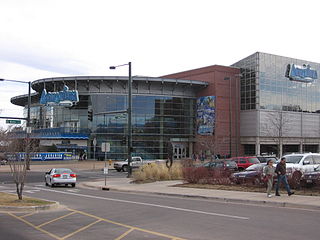
Downtown Aquarium is a public aquarium and restaurant located in Denver, Colorado at the intersection of I-25 and 23rd Ave. The 107,000 square feet (9,900 m2) main building sits on a 17-acre (6.9 ha) site adjacent to the South Platte River. Its freshwater and marine aquaria total approximately 1,000,000 US gallons (3,785,000 L), and exhibit a variety of fish and other animals.
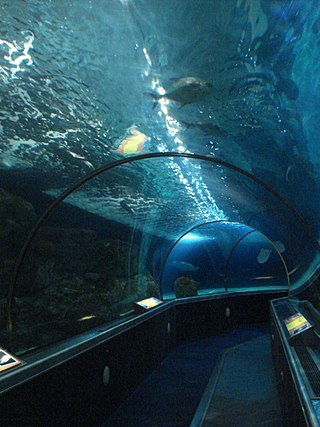
Sea Life at Mall of America is a public aquarium located in the Mall of America in Bloomington, Minnesota, United States. The 1.3 million-US-gallon aquarium contains thousands of aquatic creatures, including sea turtles, sharks, sawfish, stingrays, jellyfish and seahorses. There are eleven exhibits featured at the aquarium. The aquarium is highlighted by a 300-foot (91 m) 360° clear acrylic tunnel, which consists of four different areas housing both freshwater and salt water creatures.

The ABQ BioPark Aquarium, located in Albuquerque, New Mexico, United States is a facility of the Albuquerque Biological Park and is located next door to the ABQ BioPark Botanic Garden. The ABQ BioPark Aquarium exhibits Gulf of Mexico and South Pacific saltwater species from a variety of habitats, including surf zone, shallow waters, coral reefs, open ocean and deep ocean. The highlight of the aquarium is a 285,000 U.S. gal (1,080,000 L) shark tank with a 38-foot (12 m)-wide, 9-foot (2.7 m)-high, 8-inch (200 mm)-thick acrylic viewing window.
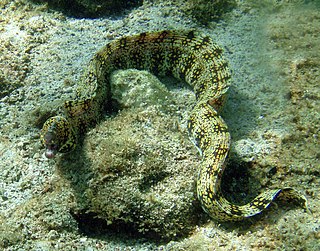
The snowflake moray, also known as the clouded moray among many vernacular names, is a species of marine eel of the family Muraenidae. It has blunt teeth ideal for its diet of crustaceans, a trait it shares with the zebra moray.

National Aquarium Denmark, Den Blå Planet is a public aquarium in Denmark. The original aquarium was located in Charlottenlund, but this facility closed in 2012 and most of the animal collection was relocated to the new and much larger aquarium Den Blå Planet in Kastrup, a suburb of Copenhagen. The National Aquarium Denmark, Den Blå Planet opened to the public in March 2013 and is the largest aquarium in Northern Europe.
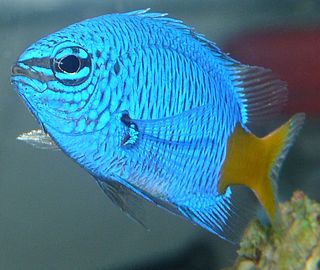
Chrysiptera parasema, also known as yellowtail damselfish, yellowtail blue damsel, goldtail demoiselle and other variations, is a saltwater species of fish from the Indo-Pacific. It was described by Henry Weed Fowler in 1918.

Coral reef fish are fish which live amongst or in close relation to coral reefs. Coral reefs form complex ecosystems with tremendous biodiversity. Among the myriad inhabitants, the fish stand out as colourful and interesting to watch. Hundreds of species can exist in a small area of a healthy reef, many of them hidden or well camouflaged. Reef fish have developed many ingenious specialisations adapted to survival on the reefs.

Boman Framji Chhapgar was an Indian marine biologist who specialized in carcinology. The author of popular accounts on marine biology under the pen-name of "beefsea", several new species of crab, mantis shrimp and fishes have been described by him.
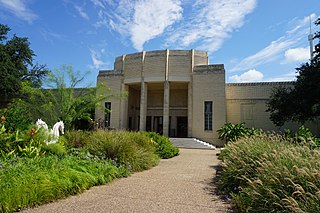
The Dallas Children's Aquarium is an aquarium located in Fair Park, Dallas, Texas, USA. It opened in 1936 as part of the Texas Centennial Exposition, becoming the first Public Aquarium in the state of Texas. The aquarium received an $8 million renovation in 2010. The Aquarium has six exhibit areas.
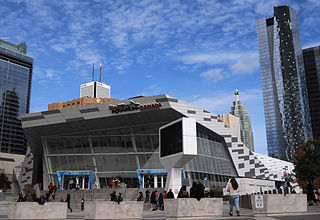
Ripley's Aquarium of Canada is a public aquarium in Toronto, Ontario, Canada. The aquarium is one of three aquariums owned-and-operated by Ripley Entertainment. It is located in downtown Toronto, just southeast of the CN Tower. The aquarium has 5.7 million litres of marine and freshwater habitats from across the world. The exhibits hold more than 20,000 exotic sea and freshwater specimens from more than 450 species.

Jagdish Chandra Bose Aquarium is situated in the Pal area of Surat, Gujarat, India. It is the first multidisciplinary underwater aquarium of its kind in the country and named after the Bengali scientist Jagadish Chandra Bose. Inaugurated on 1 March 2014 by Narendra Modi

Eilat's Coral World Underwater Observatory is a public aquarium, park and conservation center located in Eilat, Israel. It is the biggest public aquarium in Israel, and it hosts over 800 species. It was founded in 1974 and was the first of its kind. The park and aquarium is located to the south of Eilat's Coral Beach nature reserve.

Jakarta Aquarium and Safari is a marine and freshwater aquarium located within a retail and leisure complex Neo Soho in Jakarta, Indonesia. The aquarium is home to hundreds of mammal, reptile, insect and various types of Indonesian marine fish, is to introduce to the next generation the biodiversity of the archipelago starting from islands, forests, and mangroves.
























